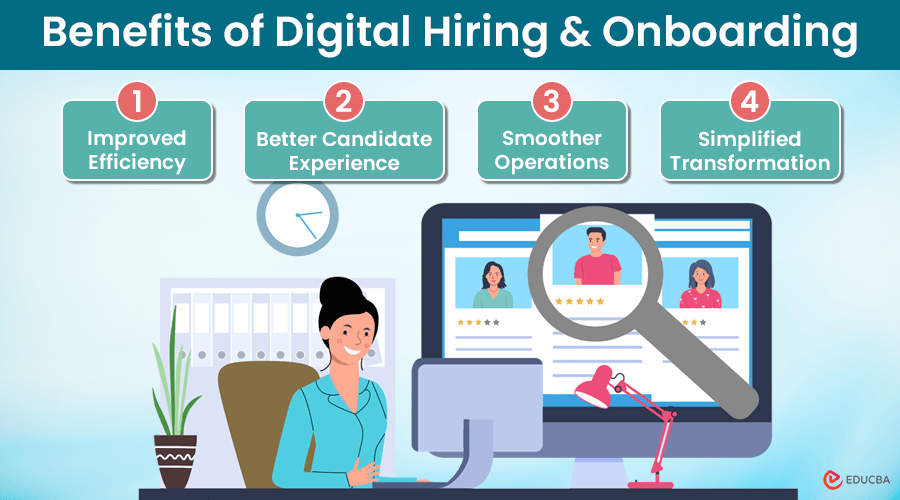
What is Digital Hiring and Onboarding?
Digital hiring and onboarding refer to using online tools and technology to manage finding, interviewing, and integrating new employees into a company. This includes everything from posting job openings online, using software to track applications, and conducting video interviews to providing digital training and resources for new hires.
The goal is to make the process faster, more efficient, and more engaging for both the company and the candidates.
Benefits of Digital Hiring and Onboarding
Digital hiring and onboarding offer several benefits to organizations. Here are some key advantages:
1. Improved Efficiency
When organizations automate their routine tasks, it reduces manual workloads, which results in faster and more efficient processes. This allows HR teams to focus on important strategic tasks instead of getting stuck with repetitive administrative work.
2. Better Candidate Experience
A digital-first strategy keeps candidates informed and engaged throughout the hiring process. Organizations can communicate clearly and timely, which improves their reputation and makes a good impression on potential employees
3. Smoother Operations
Digitizing hiring and onboarding processes reduces errors, improves communication, and creates a seamless HR workflow. This means fewer mistakes, clearer communication, and a more cohesive experience for candidates and HR teams.
4. Simplified Transformation
While digitizing your hiring and onboarding processes might seem overwhelming, the transition can streamline operations and make everything run more smoothly. Implementing digital tools can transform complex processes into more manageable and efficient workflows.
Steps to Digitize Your Hiring and Onboarding Processes
Here are some steps to consider while using the digital hiring and onboarding process:
Step 1: Evaluate and Plan Your Digital Transformation
Start by thoroughly evaluating your current hiring and onboarding processes. Identify slow, cumbersome, or error-prone stages and determine where candidates and new employees experience frustration.
Set realistic targets for your digital transformation. Focus on immediate improvements, like digitizing paperwork, and aim for long-term objectives, such as fully automated onboarding.
Step 2: Implement Applicant Tracking Systems (ATS)
Modern recruiters rely on the Applicant Tracking System (ATS) as it can efficiently handle applications and improve the candidate experience.
Choose an ATS that efficiently handles applications, integrates with your technology, and can grow with your company. The right ATS should meet current needs and adapt to future demands.
Step 3: Leverage Digital Assessment Tools
Apart from traditional interviews, use digital tools like simulations and skill tests to evaluate candidates.
Select assessments based on the position’s requirements. Make sure to test these tools for reliability and ensure they aim to reduce bias.
Step 4: Use Video Interviewing Platforms
Video interviews reduce time and costs for candidate screening, especially for remote positions or initial rounds. They combine the personal touch of in-person meetings with the convenience of online communication.
Choose a reliable and easy-to-use platform that integrates with your ATS. Features like interview scheduling, recording, and assessment tools are essential. Train your hiring team on best practices for video interviews to ensure a seamless experience.
Step 5: Enhance Candidate Engagement with Automated Communications
Automated messaging, from application confirmations to interview reminders, keeps candidates informed throughout the hiring process, maintaining engagement and a positive brand image.
Choose platforms that offer customization for each stage of the candidate’s journey. This lets HR concentrate on strategic tasks while ensuring each candidate gets an excellent experience.
Step 6: Create a Digital Employee Onboarding Experience
Digitizing onboarding improves first impressions and speeds up new hires’ productivity. A digital onboarding program can include virtual tours, digital handbooks, e-learning modules, and online forums for new hire questions.
Convert all essential onboarding documents and processes into digital formats. Enhance engagement with gamification and social learning networks.
Step 7: Employ Employee Onboarding Software
Onboarding software offers a centralized platform for managing the entire onboarding process, from paperwork to training schedules. It streamlines the welcome process, tracks assignments, and integrates with other HR tools.
Choose user-friendly software that allows customization and provides detailed reports. Good onboarding platforms automate administrative tasks and help new employees feel welcomed and valued.
Step 8: Integrate with HR Information Systems (HRIS)
A comprehensive HRIS is the backbone of a digitally transformed HR department. Integrating ATS, HR onboarding software, and other HR tech with an HRIS allows smooth information flow and efficient employee management.
Integration reduces errors and duplicates, empowering HR teams with advanced analytics and reports for smarter decision-making. Ensure your HRIS has robust integration capabilities and is compatible with your existing tech stack.
Step 9: Foster a Digital Culture and Continued Education
Digitizing hiring and onboarding is about embracing digital transformation. Provide training sessions on new technologies and foster a culture that embraces change.
Invest in continuous education so your HR team stays updated on the latest digital tools and strategies. Access to online courses, live webinars, and professional networks ensures ongoing learning.
Step 10: Measure and Adapt Based on Feedback & Analytics
Track the impact of your digital transformation on efficiency, candidate experience, and employee engagement using analytics tools. For this, you can collect feedback from new hires to know where improvements can be made. Use this information to adjust your strategies.
Digital transformation requires continuous adaptation, so staying flexible and open to evolving your methods is essential for effectively using new technologies.
Final Thoughts
Using digital hiring and onboarding processes is crucial for companies that want to attract and keep top talent. Digital tools improve efficiency, enhance the candidate experience, and streamline HR operations.
Companies can successfully embrace digital transformation by assessing current processes, implementing advanced technologies, and fostering a culture that welcomes digital innovation. The future of HR is digital, and the time to adapt is now.
Recommended Articles
We hope this article on “Digital Hiring and Onboarding” was helpful to you. To learn more about recruitment and training, refer to the articles below.

